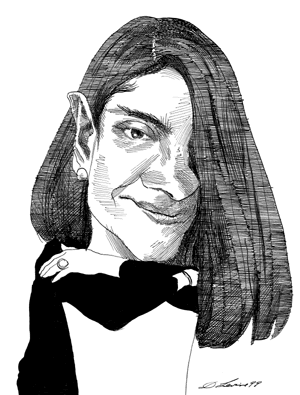In two decades and seven novels, Cathleen Schine has made a specialty of creating spirited if mildly depressive heroines in search of a brainy conceit to live by, whether it’s birdwatching (To the Birdhouse), French Enlightenment philosophy (Rameau’s Niece), Darwinian theory (The Evolution of Jane), or Flaubert’s famous dictum about Madame Bovary (She Is Me). But in Schine’s latest zingy domestic comedy, The New Yorkers, the characters don’t have conceits. They have dogs. Or they don’t—and the novel’s own conceit is that this makes all the difference. On the slightly down-at-heels Upper West Side block where the story unfolds, happiness—or the closest Schine’s brightly downbeat characters can come to it—is next to dogginess.
The block is located somewhere just around the corner from Nora Ephron territory and a few income brackets off the posher avenues familiar from Woody Allen movies. “It was never one of New York City’s fashionable blocks,” the omniscient (and occasionally intrusive) narrator tells us as the book opens. “There are no mansions there, no narrow houses of historical importance, no plaques attesting to former residents of consequence. It was not even a particularly beautiful block.” But thanks to rent control, it’s still full of quirky New York characters, “struggling musicians and actors and secretaries and window washers,… some of them growing successful, some simply growing old.”
Most of Schine’s characters would count themselves among the latter. There’s Jody, a “self-styled spinster” approaching the ominous age of forty, who spends her days teaching music at an elite private school, her nights battling hovering dissatisfaction, and the rest of her time, it seems, walking her aging white pit bull, Beatrice. In a brownstone apartment across the way, Simon, a middle-aged “asocial worker,” loses himself in novels and thoughts of his annual fox-hunting vacation. A bit further down the street, Everett, a bored fifty-year-old divorced empty nester, tends his loneliness and his obsessively neat midcentury modern décor, while a few floors below a bossy twenty-six-year-old copyeditor named Polly shares a two-bedroom with a puppy named Howdy and her slacker brother George, a former child prodigy who can’t remember what he was supposed to have been so prodigious in. Rounding out the cast are an impeccably dressed French widow with a three-legged mutt, a Holocaust-survivor divorcée with a pug, and a gay couple with two cairn terriers (not to mention five kids and two nannies), owners of an upscale corner eatery called the Go Go Grill—Chinese for “dog,” of course—where the locals and their four-legged companions gather regularly to relax and flout city sanitation rules. There’s even a withered old black-clad lady with a cane who can periodically be seen tapping her way down the block, muttering in Italian. When one of the characters spontaneously starts humming the theme from the TV show Mr. Rogers’ Neighborhood, he isn’t kidding.
Except that Mr. Rogers was never overly concerned with the ins and outs of midlife romance—not to mention pooper scoopers, leash laws, and the TV dog-whisperer Cesar Millan, matters of much concern in Schine’s novel. Indeed, The New Yorkers is not for the canine-averse, or perhaps even the canine-indifferent (though Schine’s block is puzzlingly low on children, that other scourge of the urban curmudgeon). The neighborhood dogs—captured in charming line drawings by the graphic novelist Leanne Shapton—aren’t just the unwitting cupids that set the various meandering romantic plots in motion. They also end up serving as the measure of each character’s emotional depth, and perhaps even their moral worth. Schine, through her faintly fairy-godmotherish narrator, can’t help scratching her characters behind the ears with approval each time they bend down to accept a sloppy canine kiss or otherwise start warming to their furry neighbors. When Polly spontaneously comes to the rescue of Howdy after his former owner’s suicide, the narrator declares, “I like her all the better for it.” Clearly, we’re meant to as well.
Still, Schine is able to muster a bit of sympathy for Doris, the neighborhood’s Wicked Witch, recognizable as such by her big white SUV, peculiar fake orange tan, and merciless campaign against the freewheeling neighborhood dogs and their droppings. Doris may be a cartoonish killjoy who puts on heels and Armani slacks while scavenging for empty bottles to take to the redemption center (so as not to be mistaken for a homeless person), but she’s still given a doting and rather normal-seeming husband. “Doris was considered a negative person even by those who loved her,” Schine writes, “and that much more so by those who did not. But if negativity denotes despair, then Doris was in no way negative. In truth, the unfortunate world and all its stumbling, hapless ways was the source of all her considerable joy.”
Advertisement
The same could be said of Schine’s novels, with their updated screwball sensibility and unerring if generally forgiving eye for the well-groomed neuroses of the uncomfortably comfortable classes. But the steady beat of slightly off-center one-liners and the velvety gentleness of the satire can make it easy to take Schine’s sharp psychological intelligence for granted. She is especially good at conveying the everyday perversity of emotional life (“It was unfair and unkind to be angry when someone was declaring his love for you,” one of the characters in The New Yorkers tells herself) and the confusions of those who find themselves stranded in life’s great middle, “too old for an all-consuming romantic first love, too young for a desperate, midlife infatuation.”
She’s also a deft portraitist of a certain slice of mythically mundane Manhattan life. “This is not Paris!” Doris shrieks, at a community board meeting where she has gone to press for a Department of Sanitation raid on the dog-ridden Go Go Grill. Certainly not, but Schine’s New York—with no trace of crime, ethnic tension, or fear of terrorism (the story, we’re told, happened “some years” ago, though it does contain a sequence evoking the 2003 blackout)—is on the same map as the foggy black-and-white postcard Paris of bicycles and baguettes. Even when a character ventures to Brooklyn, he finds himself in an apartment with a view of the Statue of Liberty.
There are some false notes: Would a twenty-something slacker like George, with his “unhealthy” good looks and stylishly mismatched clothes, really parade around the Upper West Side wearing a puppy in a Snugli? (Come to think of it, would he really move uptown to begin with?) And would a hip schoolmarm type like Polly, capable of launching into enthusiastic disquisitions on whether the expression “O.K.” originated with the Choctaw Indians or with the Anti-Bell-Ringing Society of Boston in 1939, really need to be introduced to the genius of Annie Hall by her older lover? (After all, where if not from Manhattan would she have gotten the idea that an affair with an uptight guy twice her age like Everett might be romantic?) But Schine nails the mysteries of Korean delis, the morning automotive ballet inspired by the city’s parking regulations, the pathos of random objects abandoned in apartment lobbies when their owners can’t quite bear to throw them away.
Schine’s people are a bit like those battered mystery novels and unopened bottles of off-brand shampoo—past their prime, but available free to the right person. Her vision of New York is romantic without being starry-eyed, depicting the city as a place where it’s possible to be disappointed and bored and still wake up believing in some version of the good old happy ending. And sure enough we get one, though not until Schine has led her characters down a series of romantic dead ends.
True love may come too often with a wagging tail attached: Doris’s comeuppance by means of a teacup Pomeranian is too cute by two thirds, while Everett’s transformation from a prickly neat freak to a drooling Animal Planet addict comes off less as convincing character development than as a forced march. Still, The New Yorkers ends up being less a paean to the slobbery pleasures of dog love than a rather melancholy meditation on the difficulties and limitations of the human variety. When Jody, mulling over a not entirely welcome marriage proposal, hugs Beatrice and thinks “It’s you I love,” the point isn’t that she has pathetically poured her emotional life into an idealized relationship with a simple-minded creature that will never wake up one morning and realize he’s sick of her. (After all, she tells herself, she’s not a thirty-nine-year-old single music teacher with a cat.) She has simply found a feeling to measure unillusioned, earthbound, everyday love against. Schine ties her bittersweet story off with a wink-free fairy-tale finish, but the “ever after” part is wisely left up for grabs.
This Issue
May 31, 2007




